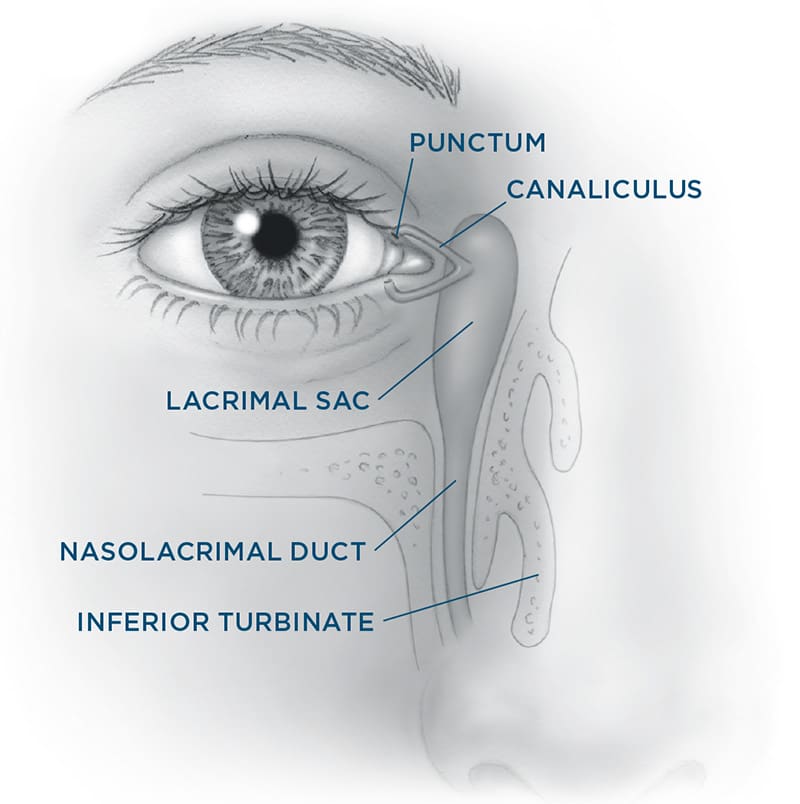Adult Tearing
Eyes that water or tear uncontrollably are common. There are several reasons why eyes can water. It occurs when there is an imbalance of the tears secreted and the ability of the tear drain to collect the tears, pumping them away from the eye. In most cases, your oculofacial plastic surgeon will have an idea of why your eyes water based on your symptoms and physical exam. Unfortunately, it is not always clear why eyes tear and there are people who may not find relief despite their doctor’s best efforts to treat them. It may be reassuring to know that in the vast majority of cases, tearing — while extremely bothersome to the patient — is usually not harmful to the eye.
To understand why eyes can water, it is helpful to understand how and why tears are made and how they ultimately drain away from your eye.

Regular Eye Moisturizing (“Blink”) Tears
The surface of your eye and insides of your eyelids are mucous membranes similar to the inside of your mouth. Mucous membranes by definition should be moist at all times. In the mouth, that moisture is provided by saliva. In the eye, this moisture is provided by tears that are made by numerous tiny glands that dot the surface of the eye and insides of the eyelids. Spontaneous blinking that occurs about 15 times a minute, spreads tears across the eye surface toward the inside corner next to your nose.

Tear Drainage
On the inside corner of each eyelid is a small drainage port called a punctum. You can see this opening if you look closely in the mirror and gently pull your lid away from your eye. Once the tears disappear down this hole, under normal conditions, they drain through canals down into the nose.
Reflex (“Cry”) Tears
In addition to the numerous glands that make baseline, eye-wetting tears, a large lacrimal gland exists under the outer upper eyelid that, in addition to being responsible for tears of joy and sorrow, also makes the tears that soothe the eye when it’s irritated from things like allergies, cutting an onion, or a stray eyelash. However, the most common reason the lacrimal gland may flood the eye is because there aren’t enough blink tears to keep the eye properly moist and the eye starts to dry out.
A dry eye can result from things like a dry, dusty, or windy environment; hormonal changes associated with pregnancy, breastfeeding, or menopause; inflammation of the eyelid edges, or blepharitis; or lids that don’t properly cover and protect the eye. The most common cause of a dry eye is age-related changes that decrease the amount of the “blink” tears. This dryness in turn triggers the “cry” tears to start flowing. There are so many tears made in these situations that they overwhelm the normal drainage pathway to the nose and instead spill onto the cheeks. Treatment for overflow tearing is directed at the underlying cause and commonly includes over-the-counter supplemental eye-wetting drops. Indeed, a watery eye is often treated, paradoxically, with tear drops. Other treatments include eyelid scrubs and warm compresses. Some people with severe and long-standing dry eyes may benefit from prescription drops. Many people with dry eyes are more symptomatic when they zone in to a visual activity like driving, reading, using a computer, or watching TV, as their blink rate diminishes.
Tear Drainage Problems
If there is a narrowing or blockage anywhere along the drain channels from the eye to the nose, even blink tears can overflow onto the cheeks. Your doctor can perform tests to determine if there is a blockage and if so, where between the eye and nose the problem lies. The exact location of the blockage will determine what treatment options are available to you. In most cases, a surgical procedure will be required to either alleviate or bypass the obstruction (see “Blocked Tear Ducts-Adults DCR”).
Another less common type of drainage problem happens when there is a problem with blinking. If the lids are weak or loose from age, paralysis, or injury, they may not blink as well. Without a proper blink mechanism, the tears have a hard time finding their way to the drainage hole at the inside corner. In this situation, your doctor may advise an eyelid tightening procedure to improve the drainage mechanics. There can be no guarantee that this type of procedure will be effective or won’t need to be repeated as the lid loosens over time but it can provide relief in some patients.
When All Else Fails
In some cases, your doctor may not be able to pinpoint the exact cause(s) of your tearing and multi-modality treatments may be recommended. In addition, there may be a role for botulinum toxin injections into or partial surgical removal of the lacrimal gland. Your doctor can give you more information on these options. You may ultimately decide to live with this aggravating, but not generally harmful condition.
Summary
Tearing eyes are a major source of discomfort and annoyance. In most cases, the tearing does not significantly harm the eye. Treatment for this condition is directed at the underlying cause. Overproduction problems (of which dry eye is the most common) are commonly treated with over-the-counter or prescription eye drops, heat compresses, or eyelid hygiene. Drainage problems may be treated with surgical procedures directed at correcting or bypassing the underlying obstruction or improving blink strength.